Relationship Spread #1
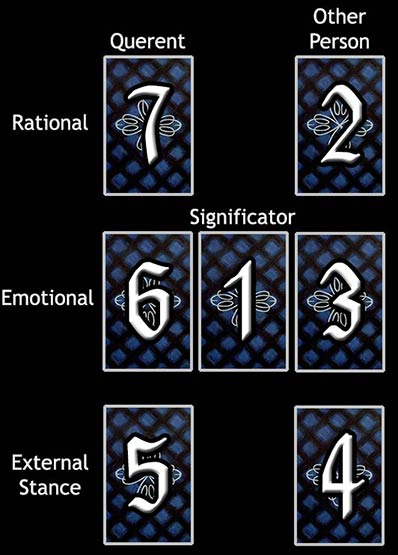
Difficulty: Easy
This tarot spread is easy to read, like a convenient chart. In this spread, court cards generally indicate actual people with the same characteristics. Knights (or corresponding princes, but not kings) and queens are meant to represent actual men and women in this tarot spread. Look for patterns in the cards as always.
Card #1 is the overall significator of the relationship. The two columns on either side of the significator characterise each individual's role in the relationship. The relationship does not have to be romantic. In fact, it could be a relationship between a person and a group, or even how two groups relate.
The top row, cards #7 & #2, is about the conscious thoughts of each person, or what they think about the relationship and likewise how they view their partner.
The middle row, cards #6 & #3, reveals the way each individual feels about the other. Emotional awareness corresponds to a person's unconscious thoughts that run deep, affecting a person in ways he or she is not fully aware of.
The bottom row, cards #5 & #4, represents the way each person behaves, in other words the stance taken regarding the relationship. The way a person acts may be genuine, but sometimes people are phony and manipulative, so it is best to weigh this card against the other person's cards to determine how they match up.
Your Relationship #1 Reading
| You | Other Person | ||
| Thought |  The Lovers |
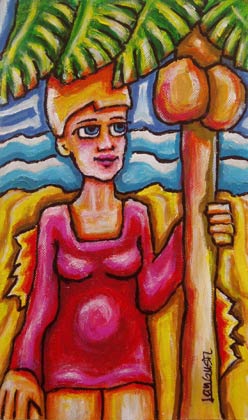 Princess of Wands |
|
| Emotion | 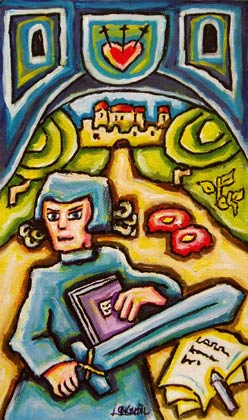 Princess of Swords |
The Significator Strength |
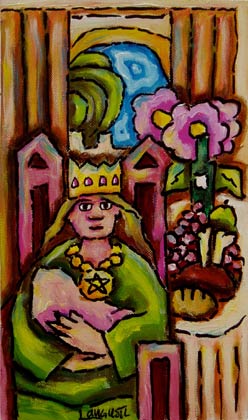 Queen of Coins |
| External Stance | 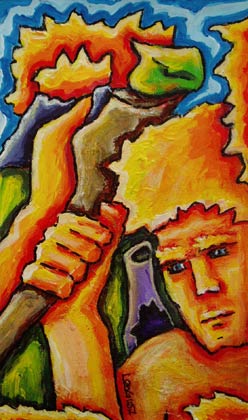 Prince of Wands |
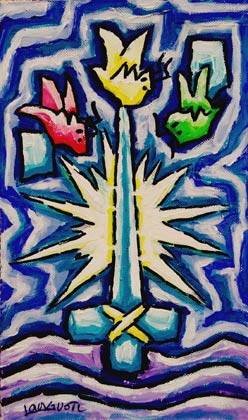 Ace of Swords |

The Significator
Strength
A sceptre and a sword seem to be fighting. Water and fire, portrayed in striking red, stand for subconscious strength. They are kept under control by the symbols of earth and air, the conscious elements, portrayed by the sword (clarity), the house (stability) and the wall (limits, firmness). The violet colour of the wall also shows a penetration of the colours red and blue.
The trees also contain this mixture of the elements, but they are growing cautiously as well as the clouds, water, which so to speak, becomes air (gaseous). They also stand for integration, which on the one hand makes us more flexible but on the other hand obscures things. The lemniscates, which can be seen clearly in magic, can be found in the two trees in the top left corner. It illustrates swinging into the next bend.

The Querent's Thoughts
The Lovers
The picture shows the connection with the opposite theme represented by two circles (blue = conscious) which combine to form an oval. The oval represents striving for unity on a higher level. The two hands stand for polarity and the confrontation with the tree of eternity and the tree of knowledge (of good and evil) with heart-shaped fruit. The serpent is coiled up at the foot of the tree of knowledge.
The yellow background emphasises the energy of the moment. Fish and water show the duality again and the produced flow of energy. The archangel Raphael watches over everyone with his blessing, indicated by God's eye.

The Other Person's Thoughts
Princess of Wands
The princess is apparently in a holiday situation with palm-trees, a beach and the sea. Fire (sun) and water (sea) come together here. Heat and refreshment alternate. There are enough references to the erotic theme in the picture.

The Querent's Emotions
Princess of Swords
She looks suspicious, she is holding her sword, ready for action. She needs to be at a distance from the castle, which is too near, but she wants to feel this nearness. The three swords in the heart above her point to injuries.
She does not seem to enjoy the beauty of the two flowers, the heads of which she has just cut off. She will perhaps be sorry later. Her books are sacred and she also writes down her thoughts. One can imagine how beautiful her hair is, which she has not completely hidden under her helmet.

The Other Person's Emotions
Queen of Coins
The queen has made her and her family home very comfortable. Everything has been arranged beautifully, there are flowers on the table, delicious food is prepared, and as well as this she is carrying a new-born baby in her arms. You would think she would need four hands to accomplish it all.
She looks rather discontented and the red colour in the picture suggests a banked-down fire. The four precious stones on the crown refer to the element earth.

The Querent's External Stance
Prince of Wands
The prince appears unexpectedly in the picture. We are slightly alarmed. He looks as though he were made of fire and he seems to be setting his surroundings on fire.
He is lifting his wand as though to fight and moves everything out of his way. But the purple vase, which he has broken in his haste, might have perhaps been useful to him. He hardly notices it; the contents are now lost. In the background a volcano is erupting and pouring its lava over the picture.

The Other Person's External Stance
Ace of Swords
The sword is rising out of the water. The blue colour in the picture symbolises clarity. The three different coloured butterflies indicate different thoughts and the perception of difference. One butterfly is sitting on the tip of the sword, a symbol of decision. The halo supports the impression of clarification and purification.
